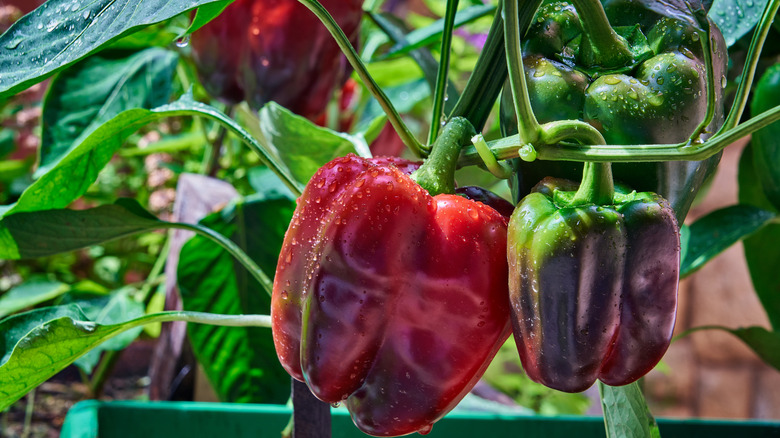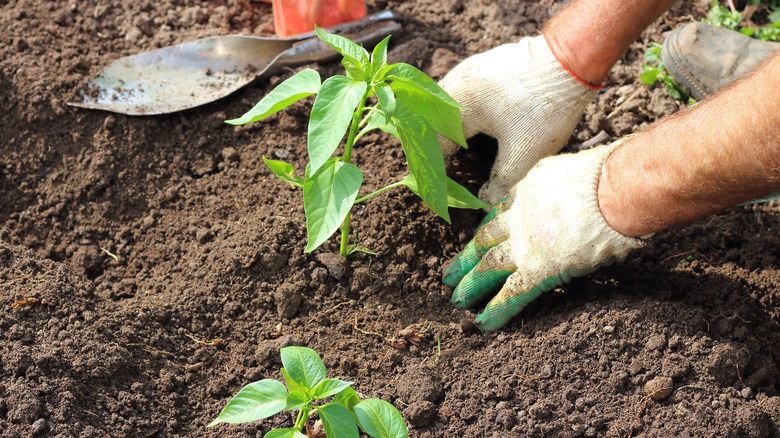Your Peppers Will Thrive Around One Stunning Self-Seeding Flower In The Garden
Growing Capsicum annuum, like bell, green, or sweet peppers, can be incredibly satisfying, but it's not always the easiest task. These plants thrive with steady warmth, plenty of sunlight, and rich, well-fed soil. But sometimes even with the right conditions, they may still benefit from a little extra help. That's where companion planting comes in. One surprising but highly effective partner for peppers is Amaranthus spp., commonly known as amaranth.
It's not just a pretty addition to the garden; it's a tough, resourceful, often self-seeding plant that brings real benefits. Amaranth has long been valued for its edible leaves and seeds, but it also improves soil health and helps protect nearby crops from pests. It doesn't rely on chemicals to stay strong and tends to hold up well during extreme weather. Planting amaranth alongside your peppers can boost your harvest and make your garden more resilient overall, giving you a healthier and more productive growing season.
Why amaranth and peppers are perfect partners
Amaranth and peppers grow well under full sun, warm temperatures, and well-drained, moderately moist soil. Since both crops thrive under the same conditions, it makes them the perfect pair! Amaranth has deep taproots that break up compacted soil. This helps water and nutrients reach the shallower roots of pepper plants more easily. Plus, it also improves soil structure and drainage over time.
The area around amaranth roots supports activity of microbes in the soil, which means better nutrient cycling and higher organic matter, both of which benefit peppers. Above ground, mature amaranth offers support, too. Its tall, leafy growth provides light shade, helping peppers avoid heat stress and reducing moisture loss from the soil. It also acts as a windbreak, protecting the delicate pepper plants. As its leaves fall and decompose, they return nutrients to the soil and help retain moisture. Amaranth also repels some bugs naturally, like aphids, thanks to compounds such as saponins. That means fewer pests bothering your peppers.
The right way to grow peppers and amaranth side by side
If you're thinking about planting peppers and amaranth together, timing is important. Wait until temperatures stay between 50 to 110 degrees Fahrenheit. Peppers do well in USDA Zones 9 to 11, and amaranth grows just fine from Zones 2 through 11. Both plants need a sunny spot with at least six to eight hours of direct sunlight a day. They like soil that's loose, well-draining, and rich in organic matter, with a pH between 5.5 and 7.0. Adding compost or aged manure before planting helps a lot, especially for peppers, which are more sensitive to soggy or compacted soil.
When it comes to watering, aim for deep, infrequent watering to keep the soil evenly moist. A layer of mulch can also make a big difference by holding moisture, reducing weeds, and keeping the soil cooler. Give peppers about 12 inches of space, with at least three feet between rows. Amaranth can be spaced 12 to 18 inches apart. The amount of space to leave between the plants is important for root development and to maintain a good airflow. If space is tight, you can pinch back amaranth to control its height. And for peppers, a simple stake or cage can keep it off the ground. Amaranth often self-seeds, so you might find it returning next year without much effort. Just remember to rotate your crops each season and keep adding compost to keep the soil healthy.


